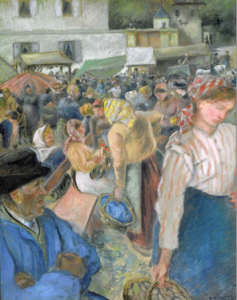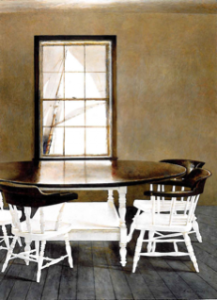I must be a magnet to natural disasters when looking at art. This past Labor Day husband Dave and I flew to New York City to hang my solo portraiture show at Pleiades Gallery in Chelsea and walked through torrents of wind and rain, the aftermath of a late summer hurricane. Busses made right-hand turns splashing us with mud and candy wrappers.
Back in our hotel wet socks hung from the curtain rod and shower bar like holiday ornamentation while we shoved wash cloths into our wet sneakers for blotting. Dave and I walked around midtown Manhattan for an entire morning and discovered only one self-service laundromat in the Murray Hill section of the city (laundry: New Absolute 212-481-0888).
The first weekend in December was the American Bankruptcy Institute’s conference in Palm Springs and Dave’s turn to find an excuse for us to travel. But before driving through California’s desert, we flew into San Francisco to view Pissarro’s People. Alaskans are used to boarding “red-eye” flights dashing off the plane to begin playing without sleep—in our case off to the Palace of the Legion of Honor Museum in Lincoln Park. The Legion of Honor, given by Alma Spreckels whose husband made fortunes in sugar, is a memorial to California soldiers who died in World War I.
Most encyclopedic museums have a few Camille Pissarro paintings off in a corner of their Impressionist galleries where Monet and Cezanne generally take center stage. Pissarro is considered a father-figure to Impressionists as he empathized with those who wished to take their easels and palettes outdoors observing the sublime of nature — wind, rain and changing light patterns. Artists like van Gogh and Gauguin were dismissing classical narrations found in French academic paintings as staged and hackneyed. The Impressionists wanted to paint actual people working in fields or dancing in cafés.
Pissarro was the only Impressionist to show in all eight Paris Impressionist Exhibitions (1874-1886). Born in 1830 in the Virgin Islands to a Portuguese-mercantile father and a native Creole mother, Pissarro resided in France most of his life. He was sent to boarding school in Paris and eventually fell under the tutelage of the artist Corot. Not being a native Frenchman, he moved his wife and children to London during the Franco-Prussian war where he met his life-long art dealer Paul Durand-Ruel. In the eighteen eighties, he met Seurat and explored Pointillism, the methodical way of juxtaposing colored paint-dots into patterns to make images.
During the late nineteenth century color theory was becoming a science and artists were experimenting with new brighter factory-made colors (example: phthalo blue). In later years Pissarro suffered from eye infections and remained indoors, painting scenes out windows.

Pissarro’s “Marketplace,” (gouache on paper, 1882), shows ordinary people going about with shopping baskets or day dreaming on benches. Pissarro turns a market scene into an energetic mosaic with splotches of red, yellow and green. The blue used on the anonymous figures helps them to recede into sidewalk carts. The Legion is a great place to eat soup or salad while overlooking the Golden Gate Bridge. This show ends January 22, 2012 but Pissarro’s work is on-line with exhibition catalogue, Pissarro’s People by Richard Brettell available through Amazon.
We left the Legion with its colonnade surrounding Rodin’s Thinker and headed South to La Quinta Resort and the ABI bankruptcy conference. La Quinta was built in 1926 as a getaway for the likes of Garbo and Dietrich. Director Frank Capra is supposed to have written It’s a Wonderful Life in this adobe retreat and you can request his room where his typewriter remains. To get to the desert, we drove through the worst Santa Ana winds in a century passing toppled palm trees while tumbleweed somersaulted across the highway smacking our rental car like large Brillo pads.
At the conference Dave listened to former New York governor Mario Cuomo speak about mediation, and I headed for the Palm Springs Museum and the exhibition Andrew Wyeth in Perspective. Wyeth, who died in 2009, is considered one of America’s best twentieth century painter/illustrators. His father was the legendary N. C. Wyeth who entertained adolescents for decades with his lively illustrations of classic children’s literature (Kidnapped and Treasure Island).

Using a very dry brush, Andrew Wyeth became proficient in watercolor and egg tempera, painting motifs found near his homes in Maine and Pennsylvania. His “Boarding Party,” (tempera on panel, 1984) contrasts nicely with Pissarro’s “Marketplace,” showing how different artists manipulate water media. Here Wyeth’s work is devoid of people or items often found on a table: plates, glassware or writing implements. Using somber colors, browns and whites he makes the viewer feel the emptiness of the room and perhaps a trace of those who left. Notice the chair is not pushed in. Like Edward Hopper, Wyeth also painted absence. This painting is also full of presence as hinted by the set sails out the sunny window. The book Andrew Wyeth in Perspective is available at the Palm Springs Museum gift shop.
We ended our long weekend away from Anchorage’s snow and ice by spending a day in Borrego Springs. The town of only several thousand is an enclave in Anza-Borrego Desert State Park. The sand there is the outwash of the Grand Canyon. Besides the usual golf and tennis, resident Dennis Avery (think peel and stick labels) commissioned outdoor statuary called “Sky Art.” Giant Sheet metal and steel sloths, tortoises and even a prospector with a gold pan and horse (who cares about authenticity?) by Ricardo Breceda roam his acreage with the Santa Rosa Mountains as backdrop.
Borrego is in the Salton Trough that has seen many geological upheavals. The area boasts a complete column of Pleistocene fossilized plants and animals. Certified volunteers under supervision of a State Park paleontologist carefully dig-up sea life fossils — the Gulf of Mexico once flowed into Southern California.
Of interest to Alaskans heading to California this winter: “Pacific Standard Time: Art in L.A. 1945-1980,” on view until April 2012 is a collaboration of over 60 cultural institutions across Southern California.




